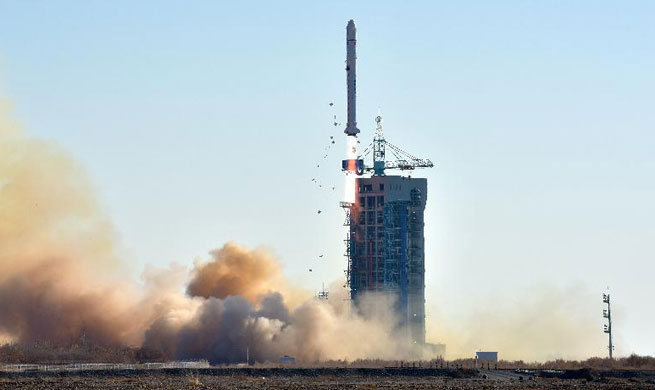SHANGHAI, Dec. 23 (Xinhua) -- The hostel Liu Yuchun used to run in northwestern Shanghai has yet to disappear from the online map on his smart phone, but Liu is sure of its fate.
Liu checks the location of the hostel through a popular app on his phone.
"Look, click on the birds-eye view, the buildings are still there, but they are being demolished," Liu said. The hostel he once owned was in a bustling urban village named Hongqi, which means "red flag" in Chinese.
The urban village, the largest in Shanghai, has been under large-scale renovation since 2016. Hongqi stands witness to the transformation of a shanty town into a cosmopolitan area that glitters just like the rest of Shanghai.
URBAN VILLAGE
Liu, from southeastern China's Fujian province, started his business in Hongqi village more than 10 yeas ago. He rented several houses and turned them into what he called "white-collar apartments."
It was a good starting point for small business owners and the city's new arrivals.
Hongqi, occupying about 400,000 square meters in Putuo district, had been home to a number of fruit wholesale and seafood markets since the late 1990s. There were also more than 1,000 small businesses such as garages, laundries, barbershops, grocery stores, printers and timber mills.
At its peak, the village accommodated some 100,000 people.
But along with the low cost of living were the smell of rotten fruit, oversized trucks charging through narrow lanes, and deep puddles after summer downpours.
Only about 30 percent of residents were long-term dwellers, Liu said. People left as soon as they could afford higher rents.
The online map will soon display Hongqi after its facelift, and the memory of the past is fading. Everything will be different, Liu said, smiling.
Gui Dexiang, 65, was eager to welcome the changes. A Hongqi resident from birth, Gui was proud to have grown up under the "red flag," a symbol of pioneering spirits.
The village was established in the late 1950s as a people's commune. It was among the first examples in China of the transformation from village to a collective share-holding company in the late 1990s. Later, an intercity bus terminal run by the village became the first in the country to sell tickets online. These were the moments of glory for residents here, said Gui.
But as the city developed, many houses in the village were leased. Some were expanded -- without permission -- to accommodate more business, he said.
In the 2010s, the village became a notorious shantytown.
"There were grave safety risks. A small fire could be very destructive in a disorderly area like Hongqi," he said. There were six high-voltage power poles in the area and many more overhead power lines.
Demolition was coming sooner or later, but the longer it waited, the harder it would be, as land ownership became increasing sophisticated over the decades and made compensation difficult, Gui said.
ON THE MOVE
It has been said that managing a big city is like embroidery: threading the needle, sewing neat stitches, and crafting a delicate pattern.
Minor renovations had been ongoing in Hongqi, but it was not until early 2016 when city planners sent troubleshooting teams to help make a difference.
District-level officials, village cadres and property developers were assembled to meet each homeowner and tenant to learn about their situations. Then they went on to provide proper and balanced compensation to help people relocate with minimal hardship.
Preferential policies were given to verified homeowners. They could get new apartments near the original location of Hongqi village, where a new commercial center is being built.
"Of course, small business owners, who had lived well here, were reluctant to move," said Fang Xing, Party branch secretary of Hongqi village.
"The government offered free rent for three months and promised to relocate them to better and more modern markets as close as possible so they could continue their business with the least personal sacrifice," Fang said.
In the future, renovation projects should be like surgery, requiring delicacy, accuracy and minimal adverse impact on the people, said Liu Shilin, an expert on city planning from Shanghai Jiaotong University.
"Plans should be designed in a really considerate way, like embroidering the city with flowers," said Liu. "And any renovation should be a project that warms people's hearts in the first place."
EVERYTHING NEW
Compensation, demolition and relocation were completed in half a year, and resettlement in about 20 months.
A total of six 25-storey buildings now stand just next to the original location of Hongqi village. They are the new homes to over 1,000 families, who were previously "urban villagers".
Earlier this month, Gui Weijun, 38, moved in with his parents, wife and son.
Outside his window is a brand new neighborhood whose name means "The Buildings of Prosperity in Shanghai."
"That old place looks calm and pretty now," he said.
Although old houses were removed, no destruction was done to the river channel that runs through the village. Instead, trees were planted and the water was cleaned.
According to Putuo district government, the construction of a 215,000-square-km green corridor in the area has already started. The project, consisting of a park and a planned artificial island in the area, will be finished in 2019.
The area may also attract industrial and innovation parks in the future, as expected by city planners and property developers.
"I am not sure whether the area will retain Hongqi as its name. Everything here is new now," said Gui.

















